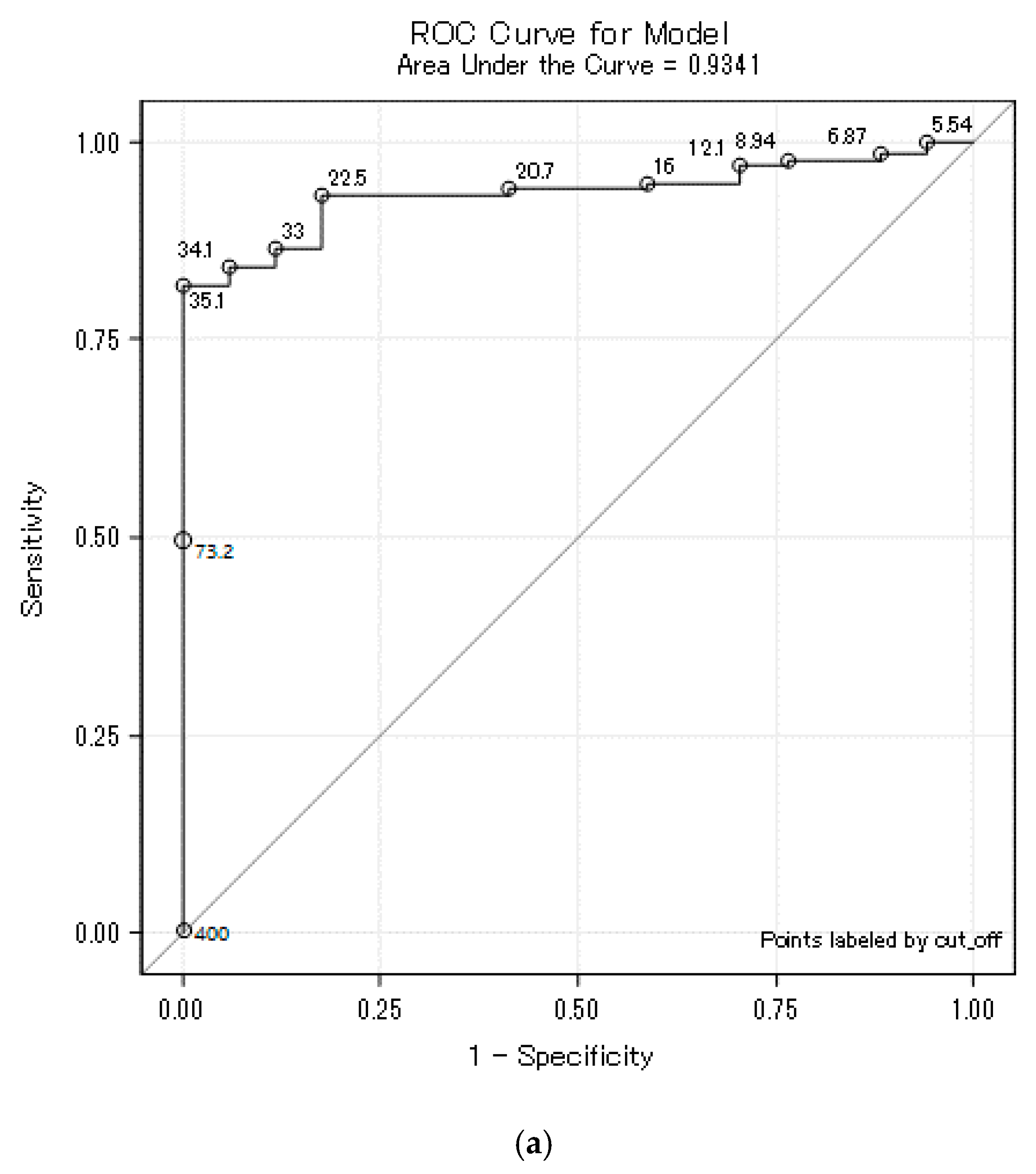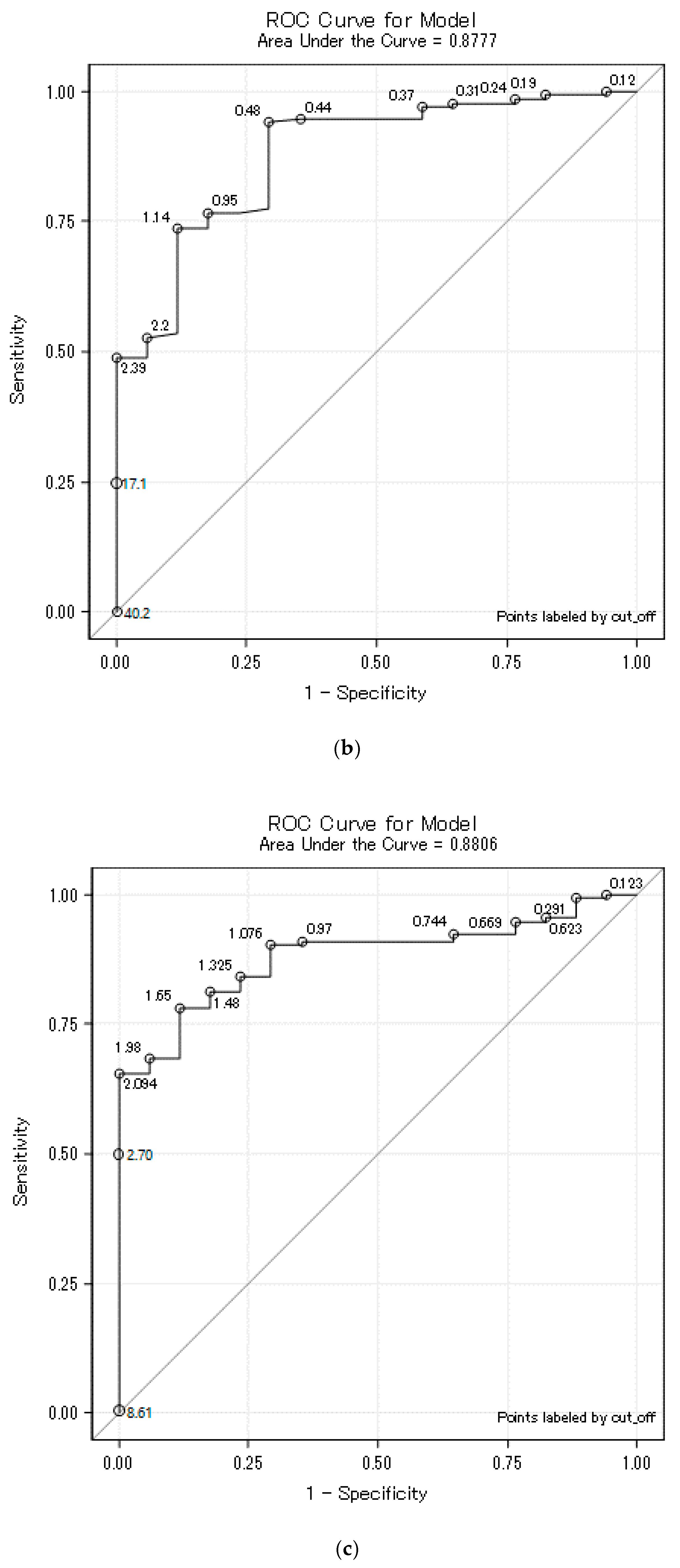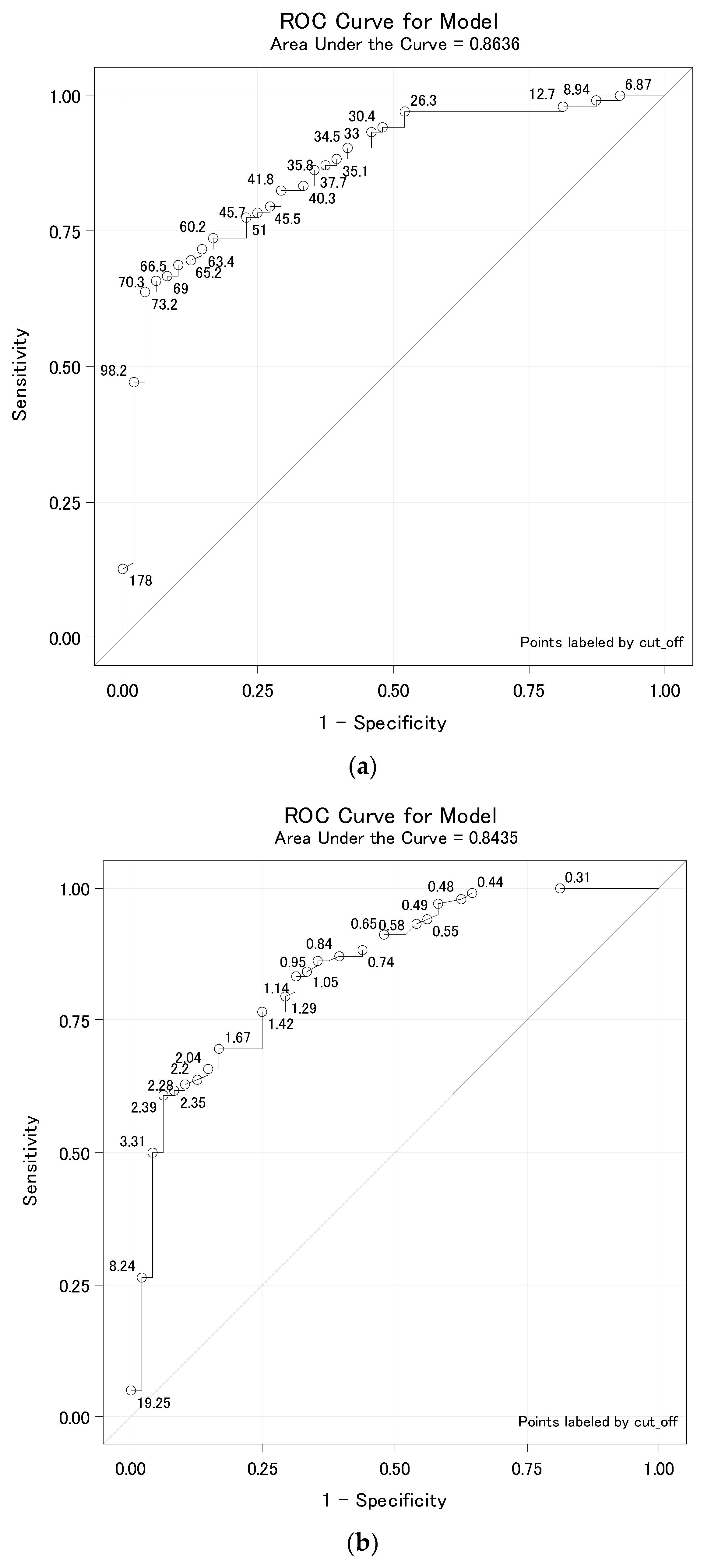Five Commercial Immunoassays for SARS-CoV-2 Antibody Determination and Their Comparison and Correlation with the Virus Neutralization Test
Abstract
1. Introduction
2. Material and Methods
2.1. Group of Patients
2.2. Serum Samples
2.3. Immunoassays
2.4. Virus Neutralization Test (VNT)
3. Statistical Methods
4. Results
4.1. Dependence of Neutralizing Antibody Titers on Age
4.2. Cut-Off Values for Screening Suitable Donors of Convalescent Plasma
5. Discussion
6. Conclusions
Author Contributions
Funding
Institutional Review Board Statement
Informed Consent Statement
Data Availability Statement
Conflicts of Interest
References
- Huang, C.; Wang, Y.; Li, X.; Ren, L.; Zhao, J.; Hu, Y.; Zhang, L.; Fan, G.; Xu, J.; Gu, X.; et al. Clinical Features of Patients Infected with 2019 Novel Coronavirus in Wuhan, China. Lancet 2020, 395, 497–506. [Google Scholar] [CrossRef]
- COVID-19 Dashboard by the Center for Systems Science and Engineering (CSSE) at Johns Hopkins University (JHU). Available online: https://www.arcgis.com/apps/opsdashboard/index.html#/bda7594740fd40299423467b48e9ecf6 (accessed on 2 March 2021).
- Poland, G.A.; Ovsyannikova, I.G.; Kennedy, R.B. SARS-CoV-2 Immunity: Review and Applications to Phase 3 Vaccine Candidates. Lancet 2020, 396, 1595–1606. [Google Scholar] [CrossRef]
- Sekine, T.; Perez-Potti, A.; Rivera-Ballesteros, O.; Strålin, K.; Gorin, J.-B.; Olsson, A.; Llewellyn-Lacey, S.; Kamal, H.; Bogdanovic, G.; Muschiol, S.; et al. Robust T Cell Immunity in Convalescent Individuals with Asymptomatic or Mild COVID-19. Cell 2020, 183, 158–168.e14. [Google Scholar] [CrossRef]
- Kellam, P.; Barclay, W. The Dynamics of Humoral Immune Responses Following SARS-CoV-2 Infection and the Potential for Reinfection. J. Gen. Virol. 2020, 101, 791–797. [Google Scholar] [CrossRef]
- Callow, K.A.; Parry, H.F.; Sergeant, M.; Tyrrell, D.A. The Time Course of the Immune Response to Experimental Coronavirus Infection of Man. Epidemiol. Infect. 1990, 105, 435–446. [Google Scholar] [CrossRef] [PubMed]
- Ledford, H. Coronavirus Reinfections: Three Questions Scientists Are Asking. Nature 2020, 585, 168–169. [Google Scholar] [CrossRef] [PubMed]
- Pickering, S.; Betancor, G.; Galão, R.P.; Merrick, B.; Signell, A.W.; Wilson, H.D.; Kia Ik, M.T.; Seow, J.; Graham, C.; Acors, S.; et al. Comparative Assessment of Multiple COVID-19 Serological Technologies Supports Continued Evaluation of Point-of-Care Lateral Flow Assays in Hospital and Community Healthcare Settings. PLoS Pathog. 2020, 16, e1008817. [Google Scholar] [CrossRef]
- Wrapp, D.; Wang, N.; Corbett, K.S.; Goldsmith, J.A.; Hsieh, C.-L.; Abiona, O.; Graham, B.S.; McLellan, J.S. Cryo-EM Structure of the 2019-NCoV Spike in the Prefusion Conformation. Science 2020, 367, 1260–1263. [Google Scholar] [CrossRef]
- Litzba, N.; Zelená, H.; Kreil, T.R.; Niklasson, B.; Kühlmann-Rabens, I.; Remoli, M.E.; Niedrig, M. Evaluation of Different Serological Diagnostic Methods for Tick-Borne Encephalitis Virus: Enzyme-Linked Immunosorbent, Immunofluorescence, and Neutralization Assay. Vector Borne Zoonotic Dis. 2014, 14, 149–159. [Google Scholar] [CrossRef] [PubMed]
- Casadevall, A.; Pirofski, L. The Convalescent Sera Option for Containing COVID-19. J. Clin. Investig. 2020, 130, 1545–1548. [Google Scholar] [CrossRef] [PubMed]
- Duan, K.; Liu, B.; Li, C.; Zhang, H.; Yu, T.; Qu, J.; Zhou, M.; Chen, L.; Meng, S.; Hu, Y.; et al. Effectiveness of Convalescent Plasma Therapy in Severe COVID-19 Patients. Proc. Natl. Acad. Sci. USA 2020, 117, 9490–9496. [Google Scholar] [CrossRef] [PubMed]
- Fejt, V.; Krátká, Z.; Zelená, H.; Fürst, T. Age Is Not a Disease: Evolution of Protective Antibodies against SARS-CoV-2 in Seniors from the Brevnice Nursing Home. Cas Lek Cesk 2020, 159, 303–311. [Google Scholar] [PubMed]
- Valcourt, E.J.; Manguiat, K.; Robinson, A.; Chen, J.C.-Y.; Dimitrova, K.; Philipson, C.; Lamoureux, L.; McLachlan, E.; Schiffman, Z.; Drebot, M.A.; et al. Evaluation of a Commercially-Available Surrogate Virus Neutralization Test for Severe Acute Respiratory Syndrome Coronavirus-2 (SARS-CoV-2). Diagn. Microbiol. Infect. Dis. 2021, 99, 115294. [Google Scholar] [CrossRef]
- Yongchen, Z.; Shen, H.; Wang, X.; Shi, X.; Li, Y.; Yan, J.; Chen, Y.; Gu, B. Different Longitudinal Patterns of Nucleic Acid and Serology Testing Results Based on Disease Severity of COVID-19 Patients. Emerg. Microbes Infect. 2020, 9, 833–836. [Google Scholar] [CrossRef]
- Letko, M.; Marzi, A.; Munster, V. Functional Assessment of Cell Entry and Receptor Usage for SARS-CoV-2 and Other Lineage B Betacoronaviruses. Nat. Microbiol. 2020, 5, 562–569. [Google Scholar] [CrossRef]
- Afzal, N.; Tariq, N.; Raza, S.; Shakeel, D. Diagnostic Accuracy of Electro-Chemiluminescence Immunoassay Anti-SARS-CoV-2 Serological Test. Cureus 2021, 13, e12588. [Google Scholar]
- Irsara, C.; Egger, A.E.; Prokop, W.; Nairz, M.; Loacker, L.; Sahanic, S.; Pizzini, A.; Sonnweber, T.; Mayer, W.; Schennach, H.; et al. Evaluation of Four Commercial, Fully Automated SARS-CoV-2 Antibody Tests Suggests a Revision of the Siemens SARS-CoV-2 IgG Assay. Clin. Chem. Lab. Med. 2021. published Ahead of print. [Google Scholar] [CrossRef]
- Weidner, L.; Gänsdorfer, S.; Unterweger, S.; Weseslindtner, L.; Drexler, C.; Farcet, M.; Witt, V.; Schistal, E.; Schlenke, P.; Kreil, T.R.; et al. Quantification of SARS-CoV-2 Antibodies with Eight Commercially Available Immunoassays. J. Clin. Virol. 2020, 129, 104540. [Google Scholar] [CrossRef]
- Ghaffari, A.; Meurant, R.; Ardakani, A. COVID-19 Serological Tests: How Well Do They Actually Perform? Diagnostics 2020, 10, 453. [Google Scholar] [CrossRef]
- Amanat, F.; Krammer, F. SARS-CoV-2 Vaccines: Status Report. Immunity 2020, 52, 583–589. [Google Scholar] [CrossRef]
- Freedenberg, A.T.; Pan, C.; Diehl, W.E.; Romeiser, J.L.; Hwang, G.; Leiton, C.V.; Muecksch, F.; Shroyer, K.R.; Bennett-Guerrero, E. Neutralizing Activity to SARS-CoV-2 of Convalescent and Control Plasma Used in a Randomized Controlled Trial. Transfusion 2021, 1–7. [Google Scholar] [CrossRef]
- Salazar, E.; Kuchipudi, S.V.; Christensen, P.A.; Eagar, T.N.; Yi, X.; Zhao, P.; Jin, Z.; Long, S.W.; Olsen, R.J.; Chen, J.; et al. Relationship between Anti-Spike Protein Antibody Titers and SARS-CoV-2 In Vitro Virus Neutralization in Convalescent Plasma. bioRxiv 2020. [Google Scholar] [CrossRef]
- Suhandynata, R.T.; Hoffman, M.A.; Huang, D.; Tran, J.T.; Kelner, M.J.; Reed, S.L.; McLawhon, R.W.; Voss, J.E.; Nemazee, D.; Fitzgerald, R.L. Commercial Serology Assays Predict Neutralization Activity against SARS-CoV-2. Clin. Chem. 2021, 67, 404–414. [Google Scholar] [CrossRef]
- Gniadek, T.J.; Thiede, J.M.; Matchett, W.E.; Gress, A.R.; Pape, K.A.; Fiege, J.K.; Jenkins, M.K.; Menachery, V.D.; Langlois, R.A.; Bold, T.D. SARS-CoV-2 Neutralization and Serology Testing of COVID-19 Convalescent Plasma from Donors with Nonsevere Disease. bioRxiv 2020. [Google Scholar] [CrossRef] [PubMed]
- Valdivia, A.; Torres, I.; Latorre, V.; Francés-Gómez, C.; Albert, E.; Gozalbo-Rovira, R.; Alcaraz, M.J.; Buesa, J.; Rodríguez-Díaz, J.; Geller, R.; et al. Inference of SARS-CoV-2 Spike-Binding Neutralizing Antibody Titers in Sera from Hospitalized COVID-19 Patients by Using Commercial Enzyme and Chemiluminescent Immunoassays. Eur. J. Clin. Microbiol. Infect. Dis. 2021, 40, 485–494. [Google Scholar] [CrossRef] [PubMed]
- Post, N.; Eddy, D.; Huntley, C.; van Schalkwyk, M.C.I.; Shrotri, M.; Leeman, D.; Rigby, S.; Williams, S.V.; Bermingham, W.H.; Kellam, P.; et al. Antibody Response to SARS-CoV-2 Infection in Humans: A Systematic Review. PLoS ONE 2020, 15, e0244126. [Google Scholar] [CrossRef]






| Characteristic | Category | n (%) |
|---|---|---|
| Gender | Female | 94 (63) |
| Male | 55 (37) | |
| Total | 149 (100) | |
| Age | Median [range] | 47.5 (4–73) |
| PCR | positivity/negativity | 138 (92)/11 (8) |
| Clinical symptoms | fever ≥ 37.5 °C | 69 (46) |
| dry cough | 51 (34) | |
| difficulty breathing or shortness of breath | 33 (22) | |
| loss of taste or smell | 59 (39) | |
| headache | 68 (45) | |
| tiredness | 105 (70) | |
| Risk factors | obesity | 17 (11) |
| smoking (last 10 years) | 17 (11) | |
| diabetes | 12 (8) | |
| cardiovascular disease | 13 (9) | |
| Flu vaccination | for season 2019 | 9 (6) |
| Manufacturer | Methodology | Antigen Used | Evaluation of the Results | Manufacturer’s Catalog Number | ||
|---|---|---|---|---|---|---|
| Negative | Gray Zone | Positive | ||||
| Abbott | CLIA | IgG NP | <1.4 | - | ≥1.4 | 6R86 |
| Diasorin | CLIA | IgG anti-S1/S2 | <12 | 12–15 | ≥15 | 311450 |
| Roche | CLIA | Total Ig NP | <1.0 | - | ≥1.0 | 09 203 095 190 |
| Beckman Coulter | CLIA | IgG anti-S1 RBD | <0.8 | 0.8–1.0 | ≥1.0 | C58961 |
| Euroimmun | ELISA | IgG anti-S1 | <0.8 | 0.8–1.1 | ≥1.1 | EI 2606-9601 G |
| Manufacturer | n | Median | Minimum | Maximum | Lower Quartile | Upper Quartile |
|---|---|---|---|---|---|---|
| Abbott | 149 | 2.66 | 0.10 | 10.12 | 1.51 | 4.91 |
| Diasorin | 149 | 66.50 | 5.54 | 400 | 34.5 | 110 |
| Roche | 149 | 73.45 | 1.84 | 155 | 31.8 | 107 |
| Beckman Coulter | 149 | 1.88 | 0.12 | 40.2 | 0.72 | 5.47 |
| Euroimmun | 149 | 2.46 | 0.12 | 8.61 | 2.46 | 4.54 |
| Abbott | Diasorin | Roche | Beckman | Euroimmun | VNT | |
|---|---|---|---|---|---|---|
| Abott | 1.00 | 0.49 | 0.65 | 0.65 | 0.49 | 0.49 |
| Diasorin | 1.00 | 0.41 | 0.76 | 0.84 | 0.72 | |
| Roche | 1.00 | 0.39 | 0.38 | 0.38 | ||
| Beckman Coulter | 1.00 | 0.73 | 0.68 | |||
| Euroimmun | 1.00 | 0.63 | ||||
| VNT | 1.00 |
| Manufacturer | Titer 80 | Titer 160 | ||||||
|---|---|---|---|---|---|---|---|---|
| Cut-Off | Sensitivity | Specificity | AUC | Cut-Off | Sensitivity | Specificity | AUC | |
| Diasorin | 35.1 | 82% | 100% | 0.9341 | 73.2 | 64% | 96% | 0.8636 |
| Beckman Coulter | 2.39 | 49% | 100% | 0.8777 | 3.31 | 50% | 96% | 0.8435 |
| Euroimmun | 2.09 | 65% | 100% | 0.8806 | 3.06 | 55% | 96% | 0.8258 |
| Abbott | 4.26 | 35% | 100% | 0.8819 | 6.00 | 26% | 96% | 0.7168 |
| Roche | 68.4 | 59% | 94% | 0.8514 | 131.4 | 13% | 96% | 0.7111 |
Publisher’s Note: MDPI stays neutral with regard to jurisdictional claims in published maps and institutional affiliations. |
© 2021 by the authors. Licensee MDPI, Basel, Switzerland. This article is an open access article distributed under the terms and conditions of the Creative Commons Attribution (CC BY) license (http://creativecommons.org/licenses/by/4.0/).
Share and Cite
Šimánek, V.; Pecen, L.; Krátká, Z.; Fürst, T.; Řezáčková, H.; Topolčan, O.; Fajfrlík, K.; Sedláček, D.; Šín, R.; Pazdiora, P.; et al. Five Commercial Immunoassays for SARS-CoV-2 Antibody Determination and Their Comparison and Correlation with the Virus Neutralization Test. Diagnostics 2021, 11, 593. https://doi.org/10.3390/diagnostics11040593
Šimánek V, Pecen L, Krátká Z, Fürst T, Řezáčková H, Topolčan O, Fajfrlík K, Sedláček D, Šín R, Pazdiora P, et al. Five Commercial Immunoassays for SARS-CoV-2 Antibody Determination and Their Comparison and Correlation with the Virus Neutralization Test. Diagnostics. 2021; 11(4):593. https://doi.org/10.3390/diagnostics11040593
Chicago/Turabian StyleŠimánek, Václav, Ladislav Pecen, Zuzana Krátká, Tomáš Fürst, Hana Řezáčková, Ondřej Topolčan, Karel Fajfrlík, Dalibor Sedláček, Robin Šín, Petr Pazdiora, and et al. 2021. "Five Commercial Immunoassays for SARS-CoV-2 Antibody Determination and Their Comparison and Correlation with the Virus Neutralization Test" Diagnostics 11, no. 4: 593. https://doi.org/10.3390/diagnostics11040593
APA StyleŠimánek, V., Pecen, L., Krátká, Z., Fürst, T., Řezáčková, H., Topolčan, O., Fajfrlík, K., Sedláček, D., Šín, R., Pazdiora, P., Zelená, H., Slouka, D., & Kučera, R. (2021). Five Commercial Immunoassays for SARS-CoV-2 Antibody Determination and Their Comparison and Correlation with the Virus Neutralization Test. Diagnostics, 11(4), 593. https://doi.org/10.3390/diagnostics11040593









